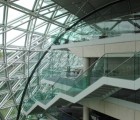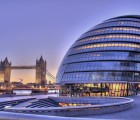Best architectural buildings in United Kingdom
Select buildings in United Kingdom.
-
Faculty of Law (Cambridge)
The Faculty of Law building, designed by the renowned British architect Norman Foster, is a striking example of modernist architecture located in Cambridge, United Kingdom. Officially known as the "Sir Joseph Hotung Building," it serves as the home of the Faculty of Law at the University of Cambridge. Here are some details about the architecture of this impressive structure:
Context and Design Concept:
Norman Foster's design for the Faculty of Law building was completed in 1995, and it stands as a bold contrast to the historic architecture of Cambridge. The design concept focused on creating a modern, functional, and innovative space for the Faculty while respecting the traditions of the university.
Materials and Construction:
The building is primarily made of steel, glass, and stone, with a sleek and minimalist aesthetic. The exterior features large expanses of glass, allowing natural light to flood the interior spaces and creating a sense of transparency and openness.
Atrium and Interior Spaces:
One of the most striking features of the building is its central atrium, which serves as the heart of the structure. The atrium is a vast, light-filled space with a soaring glass roof that floods the interior with daylight. It serves as a meeting place, study area, and circulation hub, connecting the various departments and functions of the Faculty.
Floating Podium:
The building is elevated on a "floating" podium, creating an impressive sense of lightness and openness. This design choice allows for a seamless transition between the interior and exterior spaces, with landscaped areas surrounding the building.
Functional Spaces:
The Faculty of Law building houses a range of functional spaces, including lecture halls, seminar rooms, offices, libraries, and communal areas for students and staff. The layout is designed to encourage collaboration, interaction, and the exchange of ideas among members of the Faculty.
Sustainable Features:
Norman Foster's design incorporates several sustainable features, aligning with his commitment to environmentally conscious architecture. The building's orientation maximizes natural daylight, reducing the need for artificial lighting. It also includes energy-efficient systems for heating, cooling, and ventilation.
Modernist Aesthetic:
The design of the Faculty of Law building reflects Norman Foster's signature modernist style, characterized by clean lines, geometric forms, and the use of glass and steel. The building's exterior is sleek and minimalist, with a focus on simplicity and functionality.
Awards and Recognition:
The Faculty of Law building has received numerous awards for its design excellence, including the prestigious RIBA Stirling Prize in 1996. This award recognizes the building as an outstanding example of contemporary architecture in the United Kingdom.
Overall, the Faculty of Law building by Norman Foster in Cambridge stands as a remarkable example of modernist architecture, seamlessly blending innovation with functionality. Its striking design, use of materials, and sustainable features make it a significant landmark within the historic cityscape of Cambridge.

-
London City Hall (London)
London City Hall, officially known as the "City Hall" or "The Greater London Authority Building," is a distinctive and iconic structure located on the South Bank of the River Thames in London, United Kingdom. Designed by the renowned British architect Norman Foster of Foster + Partners, the building serves as the headquarters of the Greater London Authority (GLA) and the Mayor of London. Here are some details about the architecture of this remarkable building:
Design Concept:
Norman Foster's design for London City Hall was completed in 2002 and reflects his innovative and contemporary architectural style. The design concept aimed to create a transparent, energy-efficient, and accessible civic building that represents the openness and democracy of London's government.
Form and Structure:
The building is characterized by its unique and striking form, often described as a "glass egg." It consists of a bulbous, spherical structure that sits atop a ten-story, steel-and-glass building. The spherical shape is meant to symbolize transparency, openness, and accessibility in government.
Helical Ramp:
One of the most distinctive features of London City Hall is the helical ramp that wraps around the exterior of the building, spiraling upwards from the ground floor to the top. This ramp serves as both a circulation route for visitors and a symbol of the democratic process, allowing the public to ascend and witness the inner workings of government.
Energy Efficiency and Sustainability:
The building is designed with a range of sustainable features to minimize its environmental impact. It includes natural ventilation systems, energy-efficient lighting, and rainwater harvesting. The distinctive glass facade allows for ample natural light to penetrate the interior spaces, reducing the need for artificial lighting.
Assembly Chamber:
At the heart of the building is the Assembly Chamber, where meetings of the London Assembly take place. This space is designed to be flexible and adaptable, with tiered seating for members and a circular layout to encourage interaction and debate.
Public Spaces and Accessibility:
London City Hall is designed to be a welcoming and accessible building for the public. The ground floor houses a public exhibition space, cafe, and meeting rooms. The helical ramp and open design of the building allow for easy navigation and transparency in government operations.
Architectural Materials:
The exterior of London City Hall is clad in a combination of glass and steel, giving it a sleek and modern appearance. The use of glass reflects the building's transparency and openness, allowing views both into and out of the building.
Iconic Landmark:
Since its completion, London City Hall has become an iconic landmark on the London skyline, alongside other famous structures such as the Tower Bridge and the Shard. It has received numerous awards for its innovative design and sustainable features, including the prestigious RIBA Stirling Prize in 2004.
London City Hall stands as a testament to Norman Foster's vision of modern, sustainable, and accessible architecture. Its unique form, innovative design features, and symbolic representation of democracy make it a fitting headquarters for the government of one of the world's most vibrant and diverse cities.


